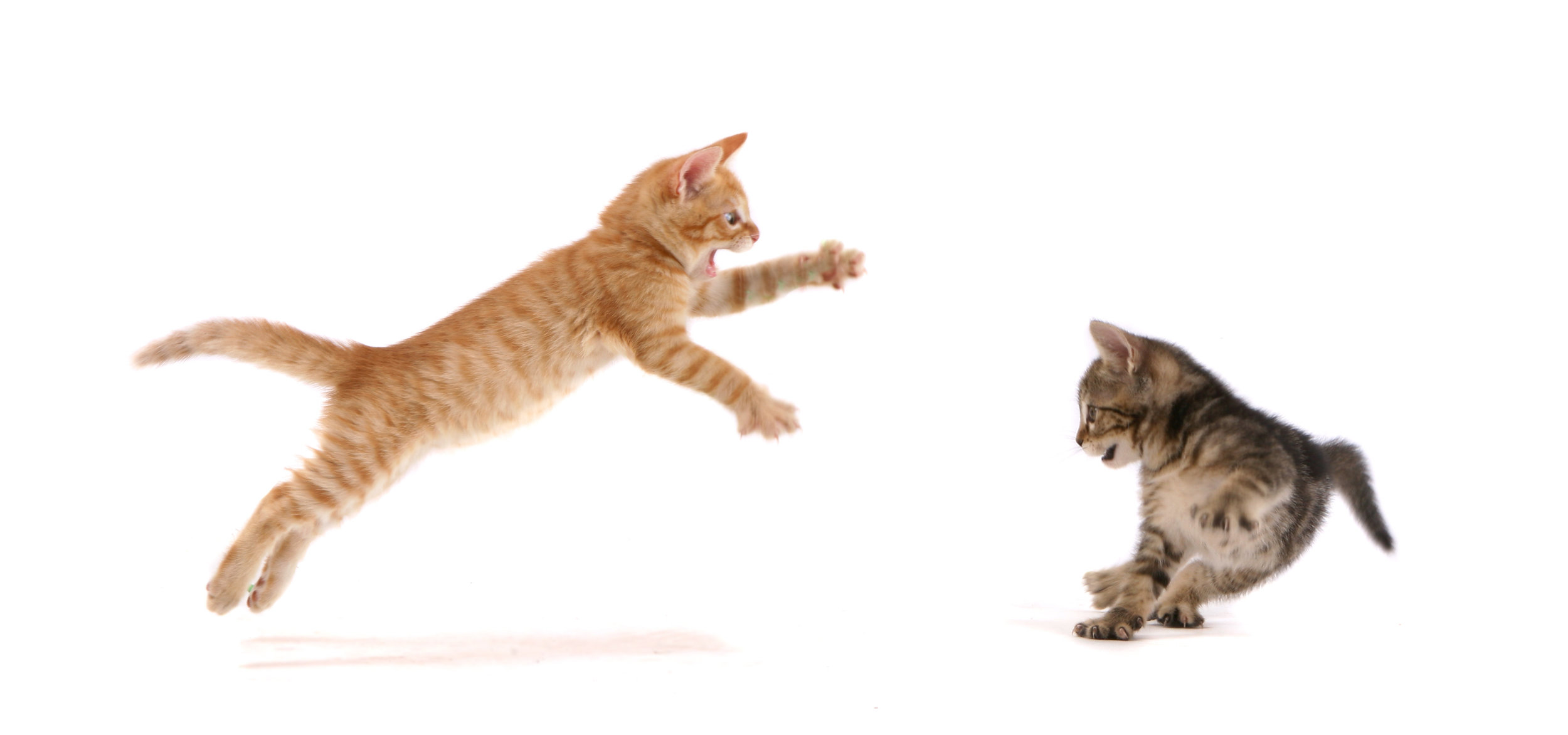- Non-recognition aggression occurs when one cat is uncharacteristically aggressive toward a companion cat after a period of separation.
- Never let your cats “fight it out.” Interrupt aggression or fighting by clapping your hands loudly, squirting the aggressive cat with a water gun, or directing compressed air (without noise) at the aggressive cat.
- The aggressive cat should be confined and gradually reintroduced to the other cat using the guidelines below.
- Non-recognition aggression may be prevented by following the measures below.
- Any sudden change in your cat’s behavior could be a sign of a medical condition requiring a visit to your veterinarian.
The Basics
Aggression refers to threats or attacks. Aggressive acts in cats include hissing, growling, swatting, chasing, and biting. Cats can have various kinds of aggressive behaviors. Non-recognition aggression occurs when one cat is uncharacteristically aggressive toward a companion cat after a period of separation. For example, after one cat returns home from a veterinary visit, the cat that stayed home is aggressive toward the returning cat, who may flee, freeze (hold still), or fight back.
The cause of this type of aggression is not fully understood. Possible causes include the following:
- The returning cat is unrecognizable and/or perceived as a threat because he or she smells like the veterinarian’s office.
- The smell of alcohol or disinfectant on the returning cat reminds the aggressive cat of a negative experience at the veterinarian’s office.
- The returning cat may have discharged his or her anal sacs at the veterinarian’s office. The discharge may contain a pheromone (a natural feline odor that humans can’t smell) that signals danger to your other cat, causing him or her to become aggressive.
What to Do
Never let your cats “fight it out.” Cats don’t resolve their issues through fighting. Interrupt aggression or fighting by clapping your hands loudly, squirting the aggressive cat with a water gun, or directing compressed air (without noise) at the aggressive cat. Try to “herd” the aggressor into a separate room so that he or she can calm down, which might take several hours. If necessary, cover the aggressor with a large towel to help calm and handle him or her. Don’t try to soothe your cats right away; just give them time to calm down. An agitated cat may become aggressive toward any pet or person who gets close. If necessary, keep the aggressor confined overnight with food, water, and a litterbox.
Reintroduce your two cats only when the aggressor has completely calmed down and is back to normal. It may help to reintroduce your cats gradually through a screen, gate, or cracked door before allowing them full access to each other. Place your cats’ food bowls on opposite sides of the barrier to encourage them to be close together while doing something they enjoy.Onceboth cats appear relaxed, open the barrier between them little by little. If your cats remain relaxed, they may be ready to be together again. If they show signs of aggression (e.g., growling, spitting, hissing, swatting), separate them again and restart the process of gradual reintroduction.
Your two cats are likely to reestablish a relationship or at least tolerate each other, but future episodes of non-recognition aggression may be likely.
Prevention
Non-recognition aggression may be prevented by taking the following measures after bringing a cat home from your veterinarian’s office and before reintroducing him or her to your other cat(s):
- Ensure that your cat has fully recovered from sedation or anesthesia.
- Bathe your cat to remove veterinary odors.
- Keep your returning cat separate from your other cat(s) to give them time to remember each other’s sounds and odors.
The following general guidelines can also help to reduce aggression:
- Neuter your cats. Unneutered males are especially prone to aggression.
- Separate your cats’ resources. Reduce competition between them by providing multiple, identical food bowls, beds, and litterboxes in different areas of your house.
- Provide additional feline-friendly areas (e.g., hiding spots) to allow your cats to space themselves out as they prefer.
- Reward your cats for getting along. Praise them or give them treats when you see them interacting in a friendly manner.
- Try using pheromones. Feliway (Ceva Animal Health, Inc., St. Louis, MO) is a product that mimics feline pheromones that may reduce tension between your cats.
Find Help
Any change in your cat’s behavior could be a sign of a medical condition. If your aggressive cat’s behavior does not improve, take your cat to your veterinarian for a checkup. In addition, you may consider contacting a certified applied animal behaviorist (CAAB or ACAAB after the last name) or a board-certified veterinary behaviorist (DACVB after the last name). These qualified experts can evaluate the problem and help you manage or resolve the conflict between your cats.
Signs of an Attacking Cat
- Staring with constricted (small) pupils
- Piloerection (raised hair) along the shoulders and tail
- Facing the returning cat and appearing ready to pounce
Signs of a Defensive (Returning) Cat
- Dilated pupils: the center (iris) of the eyes opens so that the pupils become large
- Ears pressed back against the head
- Arched back
- Piloerection (raised hair)
- Facing the aggressor sideways
- Hissing, spitting, and/or growling
- Rolling onto back to fight if there’s no escape
